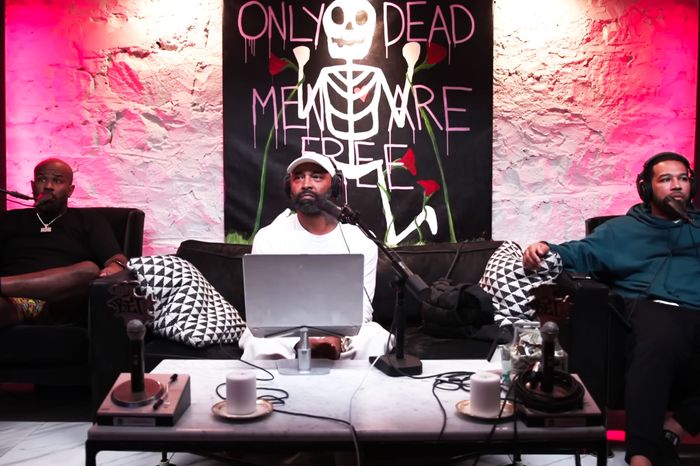
For a medium so associated with stock photos of headphones and earbuds over the years, it might come as a surprise to casual observers that the podcast business seems to be obsessed with video of late.
Last month, YouTube unveiled a dedicated hub page for podcasts, which primarily accommodates personality-driven talk shows that upload tapings of their recording sessions onto the platform to potentially reach more people. That, of course, comes as something of a formalized response to Spotify’s relatively nascent efforts to compete in the digital-video category: Just pull up the show page for The Joe Rogan Experience or Call Her Daddy on the app and you’ll see what I mean.
And according to the scuttlebutt I’ve been hearing, one of the bigger topics of public discussion at a recent major podcast-industry conference — aside from a surprise Ben Shapiro appearance, which kicked up a big ol’ kerfuffle — was all about video. As someone on the ground told me, it was one of those situations where it seemed like if a given podcast executive wanted to sound smart and convincing on a panel, all they had to do was orate vaguely about the potential of video in podcasting and how it’s still early days for all that.
There is precedent for this contemporary conversation around video in podcasting, traceable to a spate of recent consumer research studies finding that YouTube, principally known as a short-form video platform (well, short-ish, given the existence of TikTok), has been a significant driver of podcast listenership for some years now. I should say: As a matter of consumer behavior, I broadly get it; I personally use YouTube a lot like the radio to begin with, a thing I leave in the background to fill in the air while busy with other tasks, like writing this newsletter. And I know for certain that I’m far from the only one with this user behavior: A friend once described to me the way his son would often disappear into his room to “mainline YouTube.”
You could ground this data point in further historical context. In its earliest iteration back in the aughts, the technical conception of podcasting referred to on-demand RSS feed-linked media file delivery that applied to both audio and video content — until it didn’t. Much of that kind of democratized on-demand video creation and distribution migrated to YouTube and assumed the identity of that medium. Not all, of course: There were, and remain, many chat podcasts that explicitly exist as audiovisual recordings, split and distributed across both YouTube and podcast RSS feeds. That’s why, prior to Spotify exclusivity, you once could’ve found full episodes of The Joe Rogan Experience on YouTube, and why, as another example, longtime Bill Simmons heads can likely still visualize the reddish, memorabilia-filled recording studio of early BS Report episodes. You’ll notice that episodes and excerpts of The Bill Simmons Podcast are posted on YouTube as well, small drops in a sea of other audio-video podcast hybrids like the Rooster Teeth network, H3, Joe Budden, No Jumper, and so on.
My broad interpretation of why podcasting largely assumed an audio-first identity, particularly as we got deeper into the 2010s, was because, well, YouTube was right there. Why call yourself a “video podcaster” if you could just identify as a YouTuber? And why muck about with a patchworked podcast infrastructure when you have YouTube, the company, actively working to expand and optimize the business engine around the creation of such video content? The counterbalancing force was also a factor. Early audio-first wins within what was then the rudimentary podcast infrastructure went on to define the identity of the medium: public-radio repackages, tech chatcasts, comedians taking up mics, This American Life, Radiolab, WTF With Marc Maron, Serial.
In any case, even as the user-generated video and audio worlds diverged, there were still instances where you could find audio podcasts repackaged and distributed over YouTube as a secondary measure. Back when I was writing Hot Pod, I’d intermittently hear about a few chat shows reaching significant audiences whenever they threw up their episodes on YouTube and slapped a static picture of the cover art to stand in as the visual — the Loud Speakers Network was a prominent example of a publisher that I’d hear did this all the time to positive effect.
It’s not hard to intuit what’s driving this current moment around podcasting and video. Podcasting’s growing popularity in recent years has meant increasing participation by creators who’ve built followings in visual-first formats, including YouTube. And many of them, looking to diversify away from pure reliance on the opaque algorithm of YouTube (or some other platform), saw the rising but still-early profile of podcasting as a fruitful space to expand into. (That diversification has long been happening the other way around, too: note that chat-cast publishers like Crooked Media are plenty active on YouTube as well.) Spotify spotted this, and seeing an opportunity to tap into the already established and wealthy digital video market, not to mention the intertwined (highly remunerative) influencer economy. Knowing that they had already secured a strong audio-video hybrid figure in Joe Rogan, the company began to formally push their way into the format.
YouTube’s rollout of a dedicated hub page for podcasts, then, is just shrewd defensive maneuvering. Having identified that Spotify is attempting to compete in a business that YouTube already owns for the most part, all it had to do was spell out its incumbent advantage and ingest a big piece of the narrative around podcasting. It’s not like YouTube has done anything particularly technical or new; it just set up a new hub page and slapped a “podcast” label on it.
Part of the squishiness around all this is the question of what we’re talking about when we talk about podcasts. Yes, one can read this as podcasting returning to its audiovisual beginnings to some extent, but even as the medium seems to be returning to its roots, podcasting itself is no longer the same. The modern story of podcasting thus far been distinctly pegged to its identity as an extension and evolution of radio, and so this modern blurring of the lines between what you hear and what you see could well present the possibility of a branding collapse: a podcast that’s also a YouTube show that’s also a Twitch stream is kind of a hard thing to market through, frankly.
And besides the fact that the podcast industry’s newfound excitement over video is vaguely reminiscent of Facebook’s pivot to video, there’s also the reality that only a certain type of creative work — namely, chat-casts that are pegged to influencers, personalities, and celebrities — tends to fully benefit from this particular medium-fluidity.
As one veteran producer told me: “I am not anti-video podcasts, but I am worried about a larger push by the platform companies to incentivize creators to make video podcasts … Everything is pushing creators towards chat, and chat is now becoming synonymous with what a podcast is. That’s a little concerning, because a podcast can be many things, but if it only becomes the one thing that’s cheap to make and easy to sell ads on, well, then that sucks and we miss out on some pretty creative stuff.”
It’s also a little rich to see so much excitement around video among podcast suits — when in fact so few of them have actually mastered audio in the first place.
Some Podcast Recommendations
➽ Normal Gossip returned with a new season last week, and I spoke with the duo behind the hot pod of 2022 about how they actually make the thing.
➽ For those straightforward documentary-heads (what can I say, it’s my jam), here are three public-radio projects I’m planning to check out. Firstly, KUT’s The Disconnect, about Texas’s dodgy electrical infrastructure, the hook being the massive blackout that hit the state last year when it suffered an uncommonly cold winter. It just kicked off its second season. (Shoutout to Up First for the tip.) Secondly, the KNKX-Seattle Times collaboration that led to Outsiders, a 2020 doc about a Washington city’s efforts to grapple with its homelessness crisis that I really admired, has produced a new project: The Walk Home, which the team bills as “an investigation into one of the strangest and most unpredictable stories of the modern racial justice movement.” Finally, I’ve been dipping into episodes of Serum, which features a peculiar story about a peculiar person who claimed to have invented a very peculiar thing, from WHYY’s The Pulse and Local Trance Media.
➽ Speaking of public-radio pods: It looks like Brittany Luse will be the new host of It’s Been a Minute! Her watch starts on October 7.
➽ If I was interested in being, oh I don’t know, topical or something, I would probably do something like ride the recent news of the queen’s passing and recommend a vaguely relevant podcast like, say, Noble Blood.
➽ Quick shoutout to (colleague?) Kara Swisher and her new pod, On With Kara Swisher, which drops on Sep 26 …
➽ Would kill to be on the film-festival press circuit, but for now I’ll have to make do with our coverage on the site (do hit up Bilge, Alison, and Nate), and eavesdrop via Vanity Fair’s Little Gold Men …
➽ Here’s Hua Hsu on Drink Champs. Did you know the guy has a memoir coming out later this month?
➽ For the magazine, I wrote a longer review of Missing Pages, a.k.a. Books Gone Wild. Or Books Gone Bad. Whichever you prefer.


